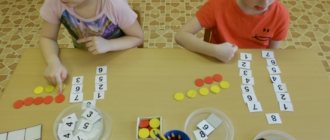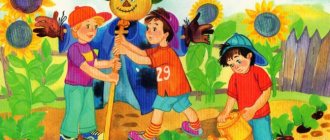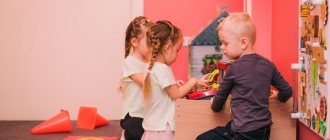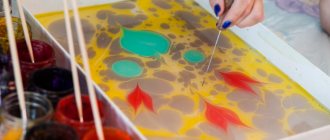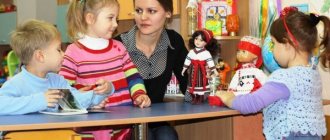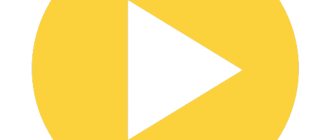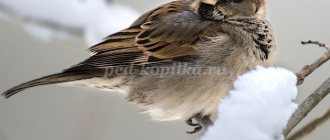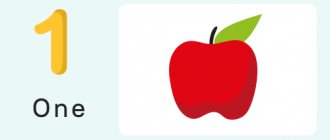The emphasis in modern education of preschool children is on developmental education. Math classes are no exception. The formation of elementary mathematical concepts develops personality, intelligence, logic and abstract thinking. It sharpens attention and memory, develops speech and promotes the most comfortable integration of the baby into the world around him. Fun math for children 3-4 years old will help develop qualities such as curiosity, goal achievement, and discipline. Introduces spatial and temporal logic.
What does mathematics teach 3-4 year old children?
Every educated parent wants to understand how well their child is developed. Are you missing any skills that are important in the modern world that you should focus on? To adequately assess children's knowledge and skills, you need to know what today's education system requires of them.
Mathematics for three-year-old children
Mathematics at 3 years old in kindergarten is not difficult. Children should:
- Master working with numbers within five. This is both an ordinal and a reverse count.
- Understand what this or that number consists of (for example, 5 is 4+1).
- When counting, use fingers, counting sticks, and other available objects.
- Correctly use the names of ordinal numbers, as well as cardinal numbers in the names of numbers.
- Recognize written numbers and be able to write them yourself.
- Name the number that comes before the given one, as well as after it.
- Use the terms “more”, “less”, “the same”. Clearly understand the difference between them.
- Master orientation in space (for example, show on a piece of notebook where the lines are higher and lower, which are on the left, right, between them, what is in the center, what is above, what is below).
For your information! Children must distinguish objects.
By size:
- Big bigger.
- Small - less.
- Short - shorter.
- Long - longer.
- Tall - higher.
- Low - lower.
- Wide - wider.
- Narrow - narrower.
Math classes
By geometric shape:
- square;
- circle;
- triangle;
- rectangle.
They must find these figures and be able to draw them, name the geometric shape of surrounding objects. Learn to identify their color. Distinguish between a circle and a ball, a square and a cube.
Math games for preschoolers 3–4 years old
Right up to school, the child’s leading activity is play. In the game, children learn letters and numbers, study the world around them, and get acquainted with the basic concepts and laws of physics, astronomy, and biology.
- What should young mathematicians aged 3–4 years old know and be able to do?
- What games should we suggest for toddlers to study the “queen of all sciences”?
- How to make home developmental activities as effective as possible?
Let's figure it out together!
Necessary knowledge base
Before drawing up a math lesson plan for children 3–4 years old, you need to figure out what kids of this age should know and be able to do:
- concentrate on the task for at least 5 minutes;
- fold a pyramid;
- collect puzzles of 4 or more fragments;
- be able to find differences between objects based on 3-4 characteristics (color, size, temperature, shape, etc.);
- find identical/similar objects in the presented set;
- find unnecessary objects in the presented set;
- operate with mathematical concepts “one”, “many”, “more”, “less”, “equal”;
- count to 5 in forward order;
- know numbers from 0 to 5;
- show the hidden number on your fingers;
- demonstrate spatial orientation skills (understand where is up and down, where is the right/left hand; understand the meaning of the prepositions “in”, “on”, “for”, etc.);
- know the basic geometric shapes: circle, triangle, rectangle;
- understand and use generalizing words: furniture, dishes, clothes, toys, vegetables, etc.
Effective developmental mathematics classes for children of primary preschool age are built according to a plan that takes into account the amount of knowledge required by children 3–4 years old.
Games to develop logic for 3–4 year olds
"Chef"
Remove some pots with lids from the kitchen cabinet. Try to choose dishes that differ in color, size, and material.
Remove the lids and place them in random order.
- Come on, kid, choose the right lid for each saucepan!
When your child completes the task independently or with your help, discuss with him what dictated his choice:
- for a large pan - a large lid;
- for red - red
etc.
"Friends and comrades"
Prepare several items that can be grouped according to their purpose. This game task helps develop logic, attentiveness, and find connections between different objects.
To play you can take:
- gloves and socks;
- markers and album;
- toothbrush and toothpaste;
- comb and hair clip;
- items of toy or real dishes.
You can use one item from a pair and replace the second with a picture. If your child copes well with the task, try replacing all the objects with pictures.
"Find differences"
Difference-finding games are great for developing attentiveness, and if you immediately indicate how many differences need to be found, they also train mental counting.
Select pictures for your child to find the differences. Write down on them how many differences you need to find. The child must circle each difference found with a pencil and put a line on the piece of paper. When the task is completed, the lines are counted to see if all the differences have been found.
Games with geometric shapes for children 3–4 years old
For the games we have prepared, you will need two sets of geometric shapes made of thick cardboard. Each set should include circles, ovals, triangles and squares of different colors and sizes.
“Repeat the picture”
Designing from flat geometric shapes is an excellent simulator for developing logic, memory, attentiveness, imaginative and spatial thinking. For children of primary preschool age, the task should be simple and understandable.
Place pictures of geometric shapes in front of your child, commenting on your actions. The child must repeat the picture according to your example.
"Count"
Geometric shapes cut out of cardboard are an excellent counting material, with the help of which it is convenient to practice comparison skills, as well as ordinal and quantitative counting.
Lay out the shapes in two rows:
Ask your child to complete your tasks and answer questions.
- Count how many circles there are in the picture.
- Count how many triangles there are in the picture.
- Count how many green figures are in the picture.
- Count how many red figures are in the picture.
- Which figures are more: red or green?
- Which shapes are more numerous: triangles or circles?
"Geometric sorter"
Use your set of geometric shapes to practice children's skill of sorting objects according to a given criterion.
The baby must follow your verbal commands:
- Place three green pieces in a row.
- Place 2 circles next to each other.
- Arrange the triangles in order from smallest to largest (pre-select three triangles of different sizes from the set).
If it is difficult for a child to fulfill your verbal requests, let him act according to a visual model for now. The main thing is to comment on what sequences and by what principles you lay out the figures.
Mathematical physical education minute
Friends, do not forget that 3-4 year old children need to move a lot. Let's combine fun outdoor games with learning math!
"Jumping gallop"
Play funny children's songs and invite your child to warm up a little. During free dances, voice commands in the following format:
- two slams;
- three floods;
- one squat;
- five slopes.
You'll probably have to do the movements with your child at first, but very soon your child will be able to handle this fun math task on his own.
"Merry round dance"
The more players there are, the more fun the game will be. This is a good entertainment option for a children's birthday party. But in the absence of company, you can easily lead a mathematical round dance together with your toddler.
Before starting the game, repeat with your child where his right hand is and where his left is. Explain where the center of the circle is. Agree that with the command “up” you need to stop and, standing on your tiptoes, stretch your arms up, and with the command “down” - squat down.
And now we can begin.
We walk in a circle to the music, following the leader’s commands:
- go left;
- let's go up;
- let's go to the center;
- let's go down.
This game teaches spatial orientation, develops auditory attentiveness, and trains teamwork skills.
“One, two - there’s a rocket”
One, two - there is a rocket. (Raise your arms straight up) Three, four - an airplane. (Spread your arms straight to the sides) One, two - clap your hands. (Clapping hands) And then on every count. (Walking in place) One, two, three, four. (Clapping hands) Arms higher, shoulders wider. (We raise our arms straight up, lower them down through the sides) One, two, three, four, (Clap your hands) And they walked around on the spot. (Walking in place)
Eureka Tips:
- Knowledge and skills are formed and accumulated gradually. Don’t expect that after the first lesson your child will remember and understand everything you wanted to convey to him. Consistency, gradualism, consolidation and repetition are the constant stages of successful teaching of mathematics in preschool age.
- Don’t forget to properly praise your child for successfully completing tasks. And keep in mind that effort is also a reason for reasonable praise.
- During games in which you need to count objects, allow and even recommend that your child count by pointing his finger at the counting object. Gradually, unobtrusively, but confidently introduce the concepts of ordinal and quantitative counting.
- Mathematics is not just about counting. Moreover, do not rush to teach your baby to count. Work on developing logic, learn to generalize and systematize, and counting, organically woven into the outline of the lesson, will be mastered on its own, by the way.
- You can learn in the game not only at home. Count the steps as you leave the house, notice round and square objects while you walk, look at the page numbers in the books you read before bed.
Friends! We wish you happy and effective parenting. See you again!
Counting and numbering numbers
The teacher’s task is to understand whether children understand the ultimate purpose of counting and why they are doing it.
Mathematics for children aged 3-4 years has its own characteristics. It is necessary to direct their attention to the study of a serious subject. For this purpose, all kinds of auxiliary materials and presentations are used.
Studying figures in preschool educational institutions
Fairy tales, toys, cubes, pictures (characters from fairy tales and cartoons printed on a color printer will be excellent handouts), lapbooks will also come in handy. They are easy enough to make yourself.
Children must master the names of numbers. But often they do not project this knowledge onto what concerns them. For example, a child knows ordinal counting perfectly, but cannot count his fingers. He simply doesn't connect the two.
Important! The teacher’s task is not only to give the concept of numbering and counting, but also to connect these things with the real world in the child’s mind.
How to Learn the Alphabet with a 4, 5, or 6 Year Old
Math exercises
Additional material will be required for math classes. The preschool educational institution recommends “Igrachka” by L. G. Peterson. This teaching aid is intended for use in mathematics lessons for 3-year-olds in kindergarten. These notebooks can be purchased online. It is also recommended to use the technique of E.V. Kolesnikova.
Educational cards
Math for a 3-year-old child begins with pictures. Five cards are made with the numbers 1, 2, 3, 4, 5.
You need to prepare pictures of the same color, but different objects. For example:
- Blue color – car, ball, flower, umbrella, etc. (all the same color).
- Red color – car, ball, pencil, umbrella, etc.
- Yellow color – car, ball, ball, spoon, etc.
- Green color – car, ball, flower, umbrella, etc.
- Black color – car, ball, pencil, umbrella, etc.
- White color – car, ball, flower, umbrella, hare, etc.
This will gather a working presenter to study the initial account. The objects in the pictures must be of different sizes.
Tasks:
- Find all red cards. Find and name each picture.
- Find all yellow cards. Find and name each picture.
- Find all blue cards. Find and name each picture.
- Find all green cards. Find and name each picture.
- Find all black cards. Find and name each picture.
- Find all white cards. Find and name each picture.
After the children have completed the task, you can move on to the next stage.
Further tasks become more difficult. You need to select all the cards where the car is drawn. All cards with a ball on them.
For your information! Having different colors is very confusing for children at first.
Comparison "More-less"
Mathematics for a 3-year-old child, which takes place in a preschool educational institution, includes the study of comparisons. The concepts of “more” and “less” are explained to children. A set of cards from previous lessons is used:
- Find all the cards with a ball on them. Then find all the cards where an umbrella is drawn. Compare the number of cards. Find which drawings there are more.
- Find all cards with a drawn flower. Then find all the cards with a drawn car. Find which pictures are smaller.
For clarity, you can put together a picture with a car and a flower. Which pictures will be left without a pair, those and more. The ones that ended earlier are smaller.
Studying the concept of “The same amount”
At the beginning of the lesson (if someone is celebrating their fourth birthday), the parents of the birthday boy brought cake and sweets. How to determine how much sweets each child needs without using numbers? Children express their suggestions.
The term “same” is introduced. The guys practice learning a new word. Problems with similar terms are solved:
- Also;
- equal quantity;
- the same.
We offer you interesting math exercises
First exercise
Take a sheet of paper and a pencil, divide it into two parts. Draw one more square on the right side than on the left.
Second exercise
Look carefully at the picture, it shows geometric shapes, count them and write the answer.
Any picture will enlarge if you click on it:
Third exercise
In this exercise, instead of a question mark, you need to use the signs >, <, =
Example: 5 > 4.
4 ( ? ) 1
2 ( ? ) 6
8 ( ? ) 4
9 ( ? ) 3
6 ( ? ) 5
Fourth exercise
In this exercise you need to place the signs >, <, =
Fifth exercise
In this exercise you need to place the signs >, <, =
Sixth exercise
What numbers make up the following numbers: 6, 9, 7, 4, 5, 8, 2, 3.
Example: the number 6 consists of the numbers 5 and 1.
Seventh exercise
Continue counting. Fill in the missing numbers.
Eighth exercise
Find all the numbers from 1 to 10 in order and connect them with a line.
Ninth exercise
The duckling solved the examples, check and correct the wrong answers with a red pencil.
Tenth exercise
How many objects are there in each picture?
Eleventh exercise
Objects are drawn on the left side, you need to count them and write the required number opposite each line.
Twelfth exercise
Write the neighbors of this number: 3, 4, 7, 2, 8, 6, 5.
Thirteenth exercise
In this exercise you need to solve examples.
Fourteenth exercise
Look carefully at the following picture, different objects are drawn on it, count them and put a sign between them: >, <.
About counting on fingers
At the first stage of learning to count on fingers, you need to firmly grasp all possible combinations. The child should not think about the answer within one hand.
Open mathematical classes in secondary groups according to the Federal State Educational Standard
Attentiveness and memory develop, including tactile memory, because counting takes place in the head. You have to hold several data in memory at the same time. A quick solution depends on intelligence and speed of perception.
Child counts on fingers
Before learning to count on fingers, the child is already familiar with the concepts of “more,” “less,” and “also.” Can count objects in order within five.
Further:
- You need to start with 1+1=2. Children put two fingers together and get 2.
- Then add another finger = 3.
- Add one more to three and get the fourth result (four).
- Add one more finger to four and get five.
Now you can master subtraction:
- Subtract one finger from five and it becomes four.
- Subtract one finger from four and it becomes three.
- If you take away one finger from three, there will be two left.
- Subtract one finger from two and one remains.
The lesson should not exceed 20 minutes. Children get tired quickly. You can diversify the lesson by changing activities - warming up, singing something, solving riddles, and so on.
Important! You can't force it. It is always easier to “lure” someone somewhere than to force them. Elements of play, competition and reward will do more and better than anything else.
